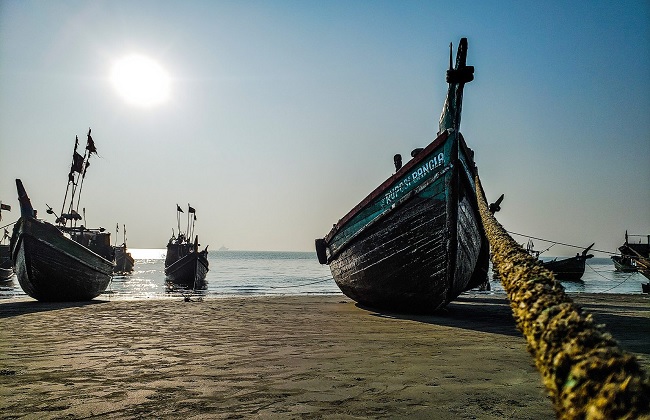
Despite enacting different laws and regulations, both old and new, Bangladesh has faced a decline in marine fish stocks and diversity over the years, thanks to the rampant use of industrial trawlers and unauthorized fishing gear in permitted fishing zones.
A study suggests that 475 species of marine fish were present in 1971 in Bangladesh, while the figures came down to 394 in 2021 due to various anthropogenic activities, including juvenile catches, overexploitation, obstructions to migratory routes, pollution and climate change.
For instance, industrial trawlers allegedly often fish at a 40 meters (131 feet) depth of the sea where only the artisanal fishers are allowed to operate their activities.
Mostafizur Rahman, a fishermen based in Chittagong, has been fishing in the Bay of Bengal for the last 40 years; he described the scarcity in this way: “To earn a modest income for one week, my colleagues and I used to stay in the sea for around about 24 hours in a week, even 20 years ago. However, nowadays, we must venture twice for the same period to get the same amount of fish.
The other important thing is, he added, was that at one time, the diversity of fish was greater, but now fishers can find only a few types.
Acknowledging the issue, Syed Md. Alamgir, director-general of the Bangladesh Department of Fisheries, said the combined impact of destructive fishing in the Bay of Bengal with the violation of regulations has significantly destabilized the coastal fisheries resource base. Because of the rising strain on the marine fishing industry, artisanal fishing is now too low-paying for many fishers to make a living.
Marine resources and overexploitation
Bangladesh has a 710-kilometer (440-mile) coastline with 121,110 square kilometers (46,760 square miles) of exclusive economic zones (EEZs) within the Bay of Bengal and is a hub of 740 aquatic species.
In addition, there are 36 species of shrimp, five species of lobsters, 12 species of crabs, 33 species of sea cucumbers, and a host of other marine organisms. The marine fisheries sector contributes about 15% of Bangladesh’s total fish production, which helps meet the population’s demands for animal protein.
According to the fisheries department, artisanal fishing with mechanized and nonmechanized gear is allowed up to 40 m deep, while industrial trawlers are limited to 40-200 m (130-660 ft). Longliners and purse seiners are allowed to operate up to 200 m to the end of the EEZ and the area beyond national jurisdiction.
According to the Fisheries Department Annual Report 2020-21, about 231 industrial trawlers out of 262 industrial fishing trawlers were active in the fiscal year 2020-21. Apart from these, 67,669 mechanized and artisanal boats were engaged in traditional fishing in the Bay of Bengal. An array of traditional artisanal fishing boats near the shore use relatively simpler gear such as gillnets, set bag nets and trammel nets, involving three to five fisheries.
Mechanized boats that carry ice cubes often fish in a contour depth of 40 m for seven to nine days. Roughly 15-30 fishers work there, depending on the size and type of gear.
Additionally, there are bottom fishing trawlers, mid-water trawlers and prawn trawlers. The gross tonnage capacity of the industrial fishing fleet is split into two groups: freezer trawlers (251-668 metric tons) with steel hulls, and wooden-bodied vessels (56-148 metric tons).
Considering the negative impacts, the government has not issued any new fishing licenses for industrial fishing vessels (mid-water trawlers, bottom trawlers or shrimp trawlers) since 2015.
To reduce the pressures on fishing and ensure sustainable management of fisheries and resources, a ban has been imposed on fishing in coastal areas with destructive gear such as set bag nets (behundi jal), push nets (shrimp fry collection nets), and other destructive gear in the coastal areas of the sea.
As bottom trawling harms breeding and nursery grounds in the sea, the provision of new licenses for bottom trawlers is also being stopped, and bottom trawlers are converting into mid-water trawlers, 68 bottom trawlers have been converted into mid-water trawlers. So far, 68 bottom trawlers have been converted into mid-water trawlers by the Ministry of Fisheries and Livestock, Alamgir said.
According to Bangladesh Fisheries Statistics 2021-22, the country’s total fish production is about 4.8 million tons. Of that, about 0.7 million tons come from marine catches.
As per the data, 3.6% more marine fish were caught in the previous fiscal year. Interestingly, production by industrial fishing trawlers has increased by 15% during the period.
Nurul Qayyum Khan, managing director of M.N. Fishing Ltd., a Bangladesh Marine Fisheries Association member, said Penaeid shrimp stocks, especially tiger shrimp, are under pressure from multiple fishing sectors. Consequently, there is a risk of depletion that may impact the livelihoods of coastal fishers and the whole coastal shrimp sector. If this happens, it will have a catastrophic effect on the country’s economy.
Protective measures
As a protective management measure, in 2000, the government declared a 698-km2 (269-mi2) marine reserve area in the Bay of Bengal to protect and conserve marine fisheries resources. Fishing is restricted in this area.
In 2019, the government declared a 3,188-km2 (1,230-mi2) area of Nijhum Dwip and the adjacent area of Hatia, in the Noakhali coastal zone, as the Nijhum Dwip Marine Protected Area.
According to the Marine Fisheries Act 2020, industrial fishing trawlers, either imported or locally built, must adhere to specifications fixed by the government. Failure to meet such specifications will result in such trawlers being refused registration.
To promote spawning and the preservation of marine fisheries resources, all types of vessels are prohibited from fishing in the Bay of Bengal for 65 days, from May 20 to July 23, every year.
To guarantee hilsa breeding, the government has instituted a 22-day yearly ban during the height of the species’ breeding season.
Some fishers, however, voiced their displeasure with the new regulation and requested that it be changed, alleging that it would severely influence their fishing operations. Their main concerns stemmed from the harsh punitive sections of the act, which prescribed lengthy prison sentences and huge penalties for violating fishing regulations.
Regarding this, Khan said many of the industrial trawler owners are planning to quit the fishing business, as the days of fishing are decreasing as well as their income, and the bans and tough regulations have made the fishing operations financially unsustainable.
(This article is republished from Mongabay under Creative Commons License)
Abu Siddique is Mongabay’s Contributing Editor for Bangladesh. He has worked for several of the leading national dailies including Dhaka Tribune, Daily Sun and The Business Standard, and has explored the remotest corners of the country in search of stories.

